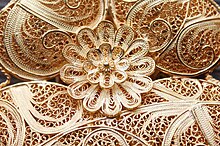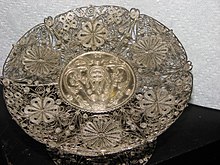This article needs additional citations for verification. (June 2008) |




Filigree (also less commonly spelled filagree, and formerly written filigrann or filigrene)[citation needed] is a form of intricate metalwork used in jewellery and other small forms of metalwork.
In jewellery, it is usually of gold and silver, made with tiny beads or twisted threads, or both in combination, soldered together or to the surface of an object of the same metal and arranged in artistic motifs. It often suggests lace and remains popular in Indian and other Asian metalwork. It was popular as well in Italian, French and Portuguese metalwork from 1660 to the late 19th century. It should not be confused with ajoure jewellery work; the ajoure technique consisting of drilling holes in objects made of sheet metal.
The English word filigree is shortened from the earlier use of filigreen which derives from Latin filum meaning thread and granum grain, in the sense of small bead. The Latin words gave filigrana in Italian which itself became filigrane in 17th-century French.[1][2]
- ^ "filigree". Oxford Advanced Learner's Dictionary. Oxford University Press. Retrieved 2022-08-17.
- ^ "filigree (n.)". Online Etymology Dictionary. Retrieved 2022-08-17.